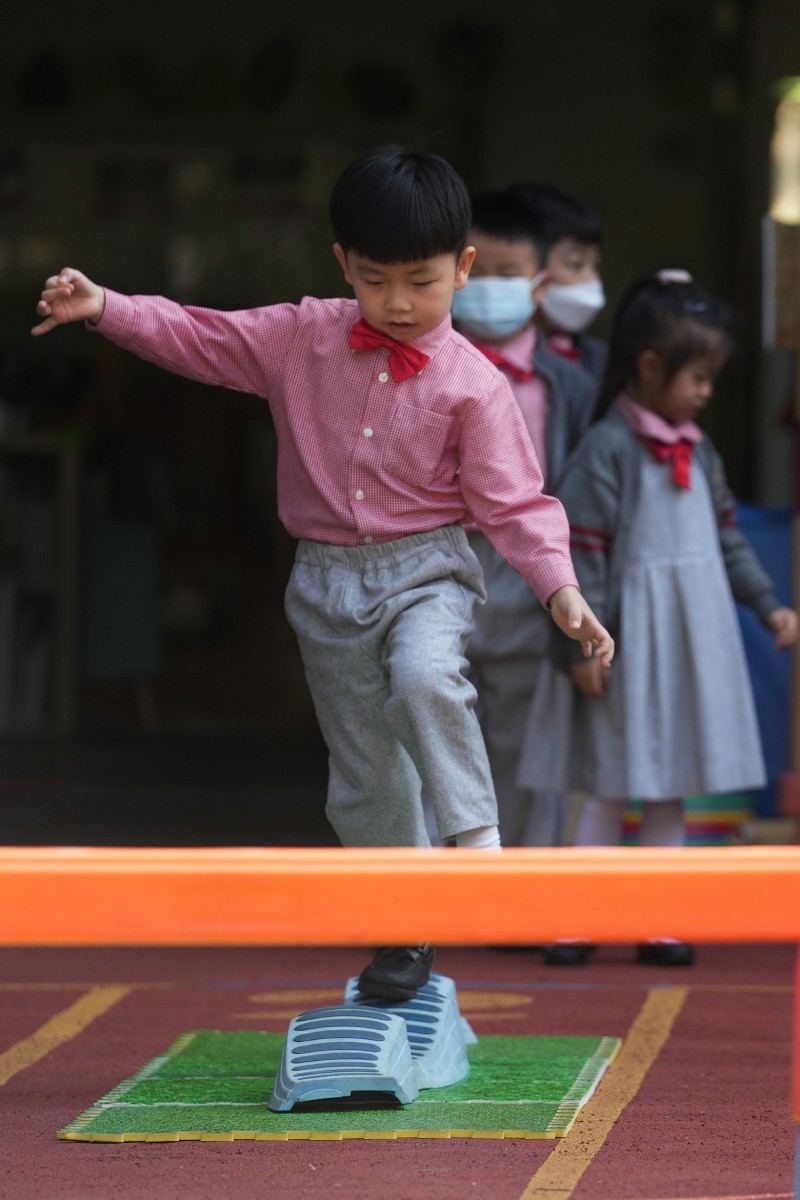
Hong Kong children with dyspraxia, a coordination disorder, need screenings and resources to move forward
- Joanne Yin, a mother, describes how occupational therapy has helped her son who wasn’t diagnosed with dyspraxia until the age of 9
- Report from Hong Kong Dyspraxia Foundation estimates 1 in 10 children in the city might have this developmental coordination disorder
 Dyspraxia affects a child’s balance and movements, so it can cause them to struggle with writing neatly or playing sports. Photo: Elson Li
Dyspraxia affects a child’s balance and movements, so it can cause them to struggle with writing neatly or playing sports. Photo: Elson LiWhen Joanne Yin’s son won an essay contest in Grade One, the pupil was told to rewrite it neatly so it could be showcased – but this was no easy task for him.
“He must have written it five or six times. And it still looked so bad. It was illegible,” the 41-year-old mum said. “I was very frustrated.”
She recalled other difficulties he faced when he was younger: struggling to sit “properly”, using his hands to eat and falling behind his peers when learning to play football.
At first, she thought he just needed to try harder.
Teen with dyslexia is helping others with the disability learn Chinese characters more easily
It wasn’t until her son was nine that an occupational therapist told her that all of these issues could be attributed to dyspraxia. Also called developmental coordination disorder, this condition affects physical movement and fine motor skills.
After learning more about her son’s diagnosis and reaching out for treatment, Yin reflected: “I think if I had known better ... I would have handled it better.”
Last year, the mother founded the Hong Kong Dyspraxia Foundation to promote awareness of this condition and help people to find treatment for it.
“I want other families to feel that there is support,” she explained. “I want other parents ... to recognise what is happening so that they can get intervention early.”
What is dyspraxia?
From last October to November, the Hong Kong Dyspraxia Foundation and The Education University of Hong Kong conducted a survey to examine the prevalence of potential dyspraxia symptoms among children in the city.
The study polled 632 parents of children aged five to 12. Respondents were asked to describe their child’s behaviour and motor performance. Researchers found 19.1 per cent of the children might have dyspraxia symptoms.
Combining data from the survey with a review of scientific articles about this condition in Hong Kong, the researchers estimated that one out of every 10 children in the city – or 9.4 per cent – had dyspraxia.
Scientists believe the condition could be caused by variations in how the brain’s neurons develop as these are responsible for communicating with the rest of the body.
Patients with dyspraxia exhibit muscle weakness and difficulty with movements. For some, their speech is affected. There is no cure or medicine for this condition, but occupational therapists, physiotherapists and speech therapists can help patients manage everyday tasks.
Looking back, Yin wished she could have understood what was happening to her son when he was younger.
“My son would sit with his legs twisted, and then he would put his legs underneath him. And he would do that whether he sat on the floor or sat in a chair,” she said.
Later, a physiotherapist told Yin that her son was sitting in that posture because he needed other parts of his body to support his back muscles and maintain balance.
Your Voice: How Hong Kong neglects its disabled community
These symptoms appeared when her son was young and became more of a problem as he grew older. For instance, while dyspraxia does not affect intelligence, he struggled with staying organised when planning essays.
Another indicator was in sports. Yin’s son started playing football when he was two, but as he got older, he couldn’t keep up with friends who began at the same time. Children with dyspraxia find it difficult to take part in activities that require hand-eye coordination and balance.
“He can play, yes. But is he in the same league as his other friends? No. And that made it very difficult for him to continue,” the mother said.
Getting help
After about two years of treatment, Yin’s son, now 11 years old, doesn’t feel like his disorder is an issue.
She remembered the joy of watching him finally ride a bicycle and acknowledged how therapy has helped.
“He comes to the gym with me. I work out; my son works out. But he doesn’t know that his trainer is a physiotherapist,” the mum said, explaining that this helped him feel less self-conscious about getting treatment.
Yin has also taken online courses about dyspraxia from groups in Britain to help address her son’s needs.
Visually impaired people train to be baristas and massage therapists
Bianca Chan, a registered occupational therapist trained in Hong Kong, stressed that the most crucial part of treating children with dyspraxia was giving them a “just-right” challenge. “The tasks should be just a little challenging and not overwhelming, so they will enjoy it more and develop an inner drive ... to do it,” she explained.
“When they know they cannot do it, they will avoid it, saying it is boring. But the underlying [reason] is that ... it affects their self-confidence.”
She recommended that children with dyspraxia try sports that do not require equipment such as running, swimming or dancing.
At home, Chan said it was vital for patients to build healthy routines by helping parents with cooking and other small tasks. “Self-care is good to train their motor planning,” the occupational therapist said.
Compliments also go a long way. Chan explained: “It’s important to build up a more positive experience to let them feel like they have control over themselves.”
But in Yin’s experience, dyspraxia is still unfamiliar to some Hong Kong professionals. The mum shared that some therapists even told her there was no need to do an assessment for the disorder. “But if you don’t do the assessment, you don’t know ... and therefore, you think it’s not going to be a problem,” she emphasised.
She pointed out that dyspraxia’s symptoms could be easily overlooked, so early diagnosis would be key.
“A child who has this problem might sit there and spend 10 hours just writing the letter. And if [they] write it enough times, [they’ll] get it,” Yin expressed. “But that means this child is not getting the help they need for the problem.”
Blind Malaysian student at Cambridge University on why she studies law
While the city’s Education Bureau recognises dyspraxia as a learning disability, Yin lamented that many schools did have not enough support for this student demographic.
Thus, in September, her foundation is starting a pilot programme with five Hong Kong schools to screen for pupils who might have dyspraxia. The schools will run a diagnostic tool, developed by occupational therapists and physiotherapists, in physical education classes.
Yin expressed hope that this initiative would reduce the barriers for students to get diagnosed and treated while giving parents the resources to support their children.
“Once you understand and you have a certain strategy, it’s a matter of a bit of time each day to go through the exercises,” the mother stressed. “If you treat it and you treat it early, then you help the child reach their potential.”
Illegible 難以辨認的
difficult or impossible to read
Occupational therapist 職業治療師
a person whose job is to help people get better after illness or injury by giving them special activities to do
Attributed 將(某種特質)歸屬於
to say or believe that something is the result of a particular thing
Dyspraxia 動作協調障礙
a condition of the brain that develops in childhood causing difficulties with physical movement and writing neatly, for example
Prevalence 普遍性
the fact of existing or being very common at a particular time or in a particular place
Neurons 神經元
a cell that carries information within the brain and between the brain and other parts of the body
Pilot 試驗性的
done on a small scale in order to see if something is successful enough to do on a large scale
